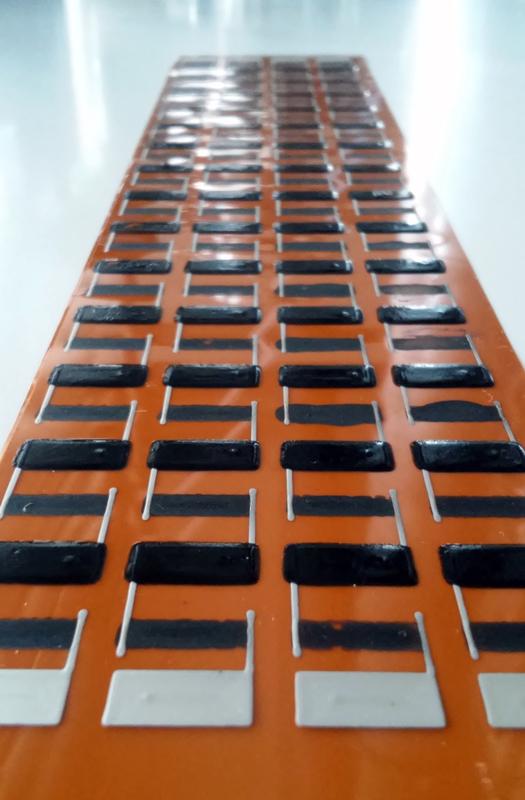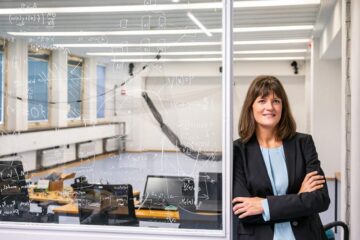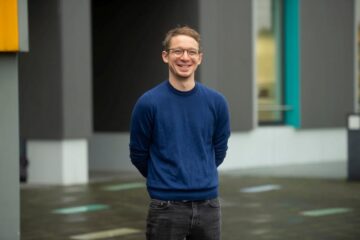Fraunhofer IWS scientists are now able to offer n-conductive polymers as processable paste

Printed TEG (thermoelectric generator) made of p- and n-conductive polymer and silver contact © Fraunhofer IWS Dresden
At first sight, for many people conductive polymers are paradox, in particular, when we think of those plastics we are surrounded by in everyday life. Nevertheless conductive polymers are already used in many technical applications, e.g. batteries, LCD screens, transistors and solar cells.
Actually it has already been known in the eighties that the electrical conductivity of polymers may reach that of metals. In 2000, the Nobel Prize for Chemistry was awarded exactly for this discovery.
The main difference between polymers and metals is the fact that in the case of metal, electrons are responsible for the electrical conduction process. However, in commercially available polymers (e.g. PEDOT: PSS) charge carriers with positive elementary charge are responsible for electrical conductivity (p-conductivity).
The design of completely electronical components requires p-conductive as well as n-conductive material. N-conductive polymers are often the famous bottleneck in many technical applications. Often they show poor electrical conductivity and structural integri-ty. Both properties strongly suffer from degradation due to environmental influences.
In 2015, however, the IWS group “Printing” successfully synthesized an n-type polymer with an enhanced conductivity of one order of magnitude (compared to the values in literature of other n-conductive polymers, http://www.iws.fraunhofer.de/en/pressandmedia/press_releases/2015/press_release_…).
Nevertheless, applications of n-conductive polymers had to face further challenges. Similar to its p-type archetype PEDOT, the IWS-developed polymer was also almost insoluble in all known solutions. This challenge has been mastered now! For the very first time a thermoelectric generator (a device which is able to generate electrical power) has been designed and tested. The Dresdner scientists are going to present their results at the “14th European Conference on Thermoelectrics” in Lisbon.
Material development, system design and manufacturing technologies of thermoelectric generators will be important topics of the workshop “Energy Harvesting Systems – FlexTEG“, taking place at the Fraunhofer IWS Dresden on September 26 – 27, 2016. Please find further information at: http://www.iws.fraunhofer.de/flexteg.
Contact:
Fraunhofer-Institut für Werkstoff- und Strahltechnik IWS Dresden
01277 Dresden, Winterbergstr. 28
Germany
Lukas Stepien
Phone: +49 351 83391-3092
Fax: +49 351 83391-3300
E-Mail: lukas.stepien@iws.fraunhofer.de
Public Relations
Dr. Ralf Jäckel
Phone: +49 351 83391-3444
Fax: +49 351 83391-3300
E-Mail: ralf.jaeckel@iws.fraunhofer.de
Internet:
http://www.iws.fraunhofer.de und
http://www.iws.fraunhofer.de/en/pressandmedia/press_releases.html
http://www.iws.fraunhofer.de und
http://www.iws.fraunhofer.de/en/pressandmedia/press_releases.html
http://www.iws.fraunhofer.de/flexteg
Media Contact
All latest news from the category: Power and Electrical Engineering
This topic covers issues related to energy generation, conversion, transportation and consumption and how the industry is addressing the challenge of energy efficiency in general.
innovations-report provides in-depth and informative reports and articles on subjects ranging from wind energy, fuel cell technology, solar energy, geothermal energy, petroleum, gas, nuclear engineering, alternative energy and energy efficiency to fusion, hydrogen and superconductor technologies.
Newest articles

Combining robotics and ChatGPT
TUM professor uses ChatGPT for choreographies with flying robots. Prof. Angela Schoellig has proved that large language models can be used safely in robotics. ChatGPT develops choreographies for up to…

How the Immune System Learns from Harmless Particles
Our lungs are bombarded by all manner of different particles every single day. Whilst some are perfectly safe for us, others—known as pathogens—have the potential to make us ill. The…

Biomarkers identified for successful treatment of bone marrow tumours
CAR T cell therapy has proven effective in treating various haematological cancers. However, not all patients respond equally well to treatment. In a recent clinical study, researchers from the University…





















